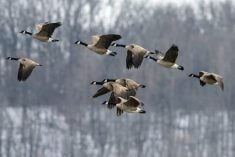Warm weather has helped speed crop development, however warm conditions are needed to advance crops during harvest.
Crop development is 10 days to two weeks behind normal in many areas.
Most crops are filling, with crops in some areas podding and finishing flowering.
In western regions, winter cereals are ready to straight cut and producers have started swathing canola.
Desiccation of peas and lentils has started, and other crops are starting to turn in some areas.
Challenges with swath dry down and baling continue for some livestock producers. Haying progress varies according to rain showers.
Read Also

Women who fed a nation
More than 40,000 young women supported the war effort between the 1940s and early 1950s, helping grow and harvest crops amid labour shortages. They were called Farmerettes.
Most areas of the province recorded rain last week ranging from trace amounts to 58 millimetres. Insects and disease have caused some damage.
Across the province, topsoil moisture on pasture and crop land is mostly adequate.
South
Harvest operations have just started for some producers with desiccation of peas and lentils and swathing of winter cereals.
Winter wheat and fall rye crops are ready to straight cut in some areas. Lack of rainfall has matured crops more quickly in some southern areas than in the rest of the province.
The Briercrest area recorded the highest amount of rainfall with 58 mm.
Haying operations in the southeast is challenging because of frequent showers and heavy dew. In the southwest haying is nearing completion.
Hay yields throughout the regions vary from 0.5 tons per acre to 3.3 tons per acre on dryland brome/alfalfa stands.
Topsoil moisture conditions are very good on cropland and hayland.
There are reports of crop damage due to insects, flooding, disease and some hail. Ascochyta blight, tan spot, bertha armyworms and grasshoppers are causing the majority of crop damage.
Central
While crops are about two weeks behind normal, there are reports of winter cereals, lentils and peas ready to straight cut and a few fields of canola being swathed.
Pulses are being desiccated in some areas as well.
Most areas recorded some welcome rainfall with the Kindersley area topping the region with 52 mm.
Hay yields range from 0.33 to2.8 tons per acre on dryland brome/alfalfa stands.
Cropland and hayland is generally in good condition, however the western areas are much drier.
Dry conditions, bertha armyworm and grasshoppers are causing the majority of crop damage.
North
Continued heat should advance crop maturity in a region that’s behind for this time of year.
Less rain in some eastern areas during the last two weeks has allowed for field conditions to dry and relieve some moisture stress of crops. However, other areas have not received significant rain over the past few weeks so crops are showing signs of stress.
Most crops are in the podding and filling stages of development with some later seeded crops finishing flowering.
Some pea crops may be soon ready for desiccation and there are reports of some cereal crops starting to turn.
The Lloydminster area received the highest amount of rainfall with 32 mm.
Hay yields range from one to 3.5 tons per acre on dryland brome/alfalfa stands. Greenfeed crops are being cut.
Most topsoil moisture on cropland and hayland is estimated to be in adequate condition.
Reported crop damage is attributed to bertha armyworms, fusarium and dry conditions. Grasshoppers have also reached economic thresholds in some cases and control is being warranted. Lygus bugs are showing up in canola as well.














